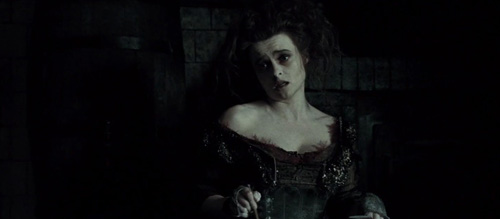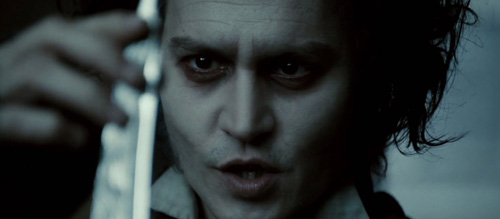‘Sweeney Todd: The Demon Barber of Fleet Street’ at 15 – Review
Sweeney Todd: The Demon Barber of Fleet Street (2007)
Director: Tim Burton
Screenwriter: John Logan
Starring: Johnny Depp, Helena Bonham Carter, Alan Rickman, Timothy Spall, Sacha Baron Cohen, Jamie Campbell Bower, Laura Michelle Kelly, Jayne Wisener, Ed Sanders
Gruesome, disturbing, and tragic, Sweeney Todd: The Demon Barber of Fleet Street still sends shivers down our spines 15 years later. Stephen Sondheim’s genius bleeds through his complex, angular composition to give the story both edge and depth. Tim Burton’s distinctive style builds a world of darkness and expresses the characters’ warped interiority. The film hypnotizes you and keeps you locked in until the shocking, grim finale.
We are first introduced to the titular murderous barber (Johnny Depp) in 1846 on a ship pulling into foggy London. Fifteen years earlier, then by the name of Benjamin Barker, he was convicted of a crime he didn’t commit and sent to Australia while his wife, Lucy (Laura Michelle Kelly), was assaulted by Judge Turpin (Alan Rickman). Now as Sweeney Todd, the barber has come home to exact revenge on the sinister judge for making the arrest and breaking up his family.
Todd returns to his former home, which has been left abandoned with peeling wallpaper and shattered mirrors, and meets Mrs. Lovett who runs the meat pie shop downstairs. She informs him that, after the assault, Lucy poisoned herself with arsenic and Turpin took charge of the Barkers’ daughter, Johanna (Jayne Wisener), as his ward. This revelation only fuels Todd’s anger and, with his silver razors in hand, his ‘arm is complete again.’ A musical motif that plays throughout the film punctuates his declaration and foreshadows his upcoming killing spree as the notes are inspired by the hymn “Dies irae”, often referenced in music to evoke themes of death and dying.
After the death of his first victim, a fellow barber (Sacha Baron Cohen) who remembered Barker from the old days, Todd has an epiphany that ‘we all deserve to die.’ In an evocative shot by cinematographer Dariusz Wolski, the killer’s face is splintered by the shards of a broken mirror, externalizing his descent into madness. Then, Burton stages a spectacular sequence in which Todd roams the streets of London taunting potential customers/victims as they appear not to see him. A cut back to him at home with Mrs. Lovett reveals that it was all in his head. This is a rare example of a scene that is more enthralling and translates better onscreen than on the stage.
Mrs. Lovett then has the ghastly idea to dispose of the bodies by grinding and cooking them in her meat pies. Todd slashes through London society as Mrs. Lovett adjusts her recipe accordingly. With the help of Tobias (Ed Sanders), a young apprentice who is unaware of the atrocities, she serves her cannibalistic delicacies to satisfied (and unknowing) customers and her business is booming for the first time. A beggar woman notices black, foul-smelling smoke billowing from the pie shop’s chimney and she tries to warn passers-by that something is terribly wrong, but no one listens.
In the meantime, a sailor named Anthony (Jamie Campbell Bower) observes Johanna staring longingly out of her bedroom window and falls in love with her beauty and innocence. However, when Turpin realizes Anthony’s attraction to his ward, he sends Johanna to an asylum. Anthony runs to tell Todd, whom he met on the ship bound for London, that they must save her, though oblivious to Todd’s relationship to Johanna and his violent crimes. Together, they plan for Todd to distract the judge with a free shave while Anthony breaks her out of the asylum. The finale is both bloody and heartbreaking, and the twist will shock you.

Watching Sweeney Todd is an intensely physical experience. Through Sondheim’s graphic music and lyrics, as well as Burton’s vivid direction, the film manipulates all five senses and evokes visceral reactions to the horrors that play out onscreen. This is amplified by the silver patina that covers most scenes. The discolouration embodies the bleakness and immorality of the characters, while exaggerating the ruby blood splatters and Todd’s red-soaked sleeves. Burton’s expressionistic composition and staging create a surreal space in which we experience the shadows and darkness which live inside Todd’s mind and that he projects, fairly or unfairly, onto the world. Critics agree that the film is a near-perfect musical adaptation that, as Moira Macdonald of The Seattle Times writes, Burton ‘was born to direct.’
In fact, according to Los Angeles Times contributor Paul Brownfield, Burton was initially enamoured with the story while on holiday in London from his studies at CalArts. He began working on a film version after seeing the West End production of Sondheim’s musical in the early 1980s, but it was never realized. Finally, in 2006, acclaimed director Sam Mendes stepped back from the DreamWorks adaptation and Burton was brought on as a replacement. In the end, the auteur’s ghoulish, expressionistic style was most suitable to bringing this story to life.
The Demon Barber of Fleet Street is also not the first retelling of this macabre tale. The murderous barber originally appeared in a 17th-century penny dreadful, published in The People’s Periodical. In 1847, he graced the stage at the Hoxton Theatre in the play “The String of Pearls: The Fiend of Fleet Street”, which served as the inspiration for Christopher Bond’s 1973 stage production, “Sweeney Todd: The Demon Barber of Fleet Street”, and then Stephen Sondheim and Hugh Wheeler’s 1979 Broadway musical adaptation. Part of the film’s appeal is thus due to the character’s long lineage and legendary status as a mainstay of British pop culture.
Johnny Depp as the homicidal barber is a chameleon whose steep crescendos from distraught family man calmly plotting revenge to maniacal serial throat-slasher elicit sympathy and terror. His vocal performance is admirable and his cockney accent is convincing, though snippets of Jack Sparrow occasionally slip through. Bonham Carter and Rickman are perfectly cast as the scheming baker and revolting villain, while Bower’s performance stands out for his ability to swing seamlessly from knight in shining armour to obsessive lover with flashes of insanity darting in his eyes during his performance of ‘Johanna.’ Burton’s nightmarish world is complete with an exceptional wardrobe designed by Colleen Atwood, winner of the Academy Award for Best Costume Design for Alice in Wonderland (2010), another one of their whimsical collaborations.
Film and television are filled with morally ambiguous hero-villains who attain our compassion for the tragedies they’ve endured, yet disturb and terrify us with their sometimes vicious retributions. In Sweeney Todd, however, we witness a special union of razor-sharp melodies, bone-chilling performances, and surreal staging that pull on our heartstrings and send us cowering in fear. Fifteen years later, the movie industry and our own expectations may have changed, but the film’s powerful effects certainly have not.
Score: 22/24
By Emily Nighman
Recommended for you: Every ‘Sweeney Todd: The Demon Barber of Fleet Street’ Song Ranked


